It is not every day that one finds a museum inside a train station, or at least not a museum as vast and filled with masterpieces as the Musée d’Orsay in Paris, known worldwide as the home of the Impressionists. In fact, the museum, one of the most visited museums on the globe with more than three and a half million people visiting during the year, is a singular institution housed in the old Orsay station, which was built for the 1900 Paris World’s Fair: the project had been entrusted in 1898 to Victor Laloux, who was supposed to think of a large station that would serve as a more central terminus than the gare d’Austerlitz. For the site, a piece of land was chosen on which had formerly stood the cavalry barracks and the Palais d’Orsay, built between 1810 and 1838: it had been first the seat of the Court of Accounts and then the Council of State. However, the two buildings were burned down in 1871 during the Paris Commune, and by 1898 they were just two ruins. It took only two years to inaugurate the station, which opened on July 14, 1900, and featured a huge metal vault, in the modernist style, 32 meters high, 40 meters wide and 138 meters long. For nearly forty years, that is, until 1939, the gare d’Orsay fulfilled its function as a train station, partly with the help of theluxury hotel that flanked it and was similarly designed by Laloux.
The station quickly became obsolete, however, so that by 1939 the bulk of the traffic was headed to Austerlitz station: trains continued to arrive at the gare d’Orsay until the 1950s, after which the station fell into disuse and was abandoned, and the hotel was also closed in 1973. There was therefore the problem of having to convert such a large structure back into something else: it was thought to demolish it to build a new, more modern hotel in its place, but in 1973 the French Museums Directorate launched another project, which involved setting up a museum devoted to the art of the second half of the 19th century inside the former station. Advocating the cause of the museum was the president of the republic Valéry Giscard d’Estaing, and as we can well imagine, he eventually prevailed: thus, in 1978, Orsay station was listed as a historical monument and a foundation was established to start work on the museum. The project was entrusted to the firm ACT-Architecture, whose task was not to disrupt Laloux’s structure, but simply to adapt its function. On December 1, 1986, President François Mitterrand officially inaugurated the Musée d’Orsay, and on December 9 the new institution began to welcome the public.
The museum’s collections are located on three floors. On the ground floor, the rooms are located on either side of the central corridor. One then goes up to the middle floor, where the rooms are arranged around the terraces overlooking the first floor, and finally reaches the upper level, located above the track atrium. There is also a bit of Italy in the design of the Musée d’Orsay: when the station was turned into a museum, the layouts were designed by Gae Aulenti, in collaboration with Italo Rota, Piero Castiglioni and Richard Peduzzi. The difficulty lay in creating an organic exhibition in a building characterized by very different spaces (in terms of location, volumes, materials used, and so on). “My principle,” Gae Aulenti would later explain, “was to protect the identity of the Laloux building as best as possible without giving up the identity of the contemporary building. We designed the exhibition space for more than 4,000 works, studying for each the visual relationship between work and visitor.”
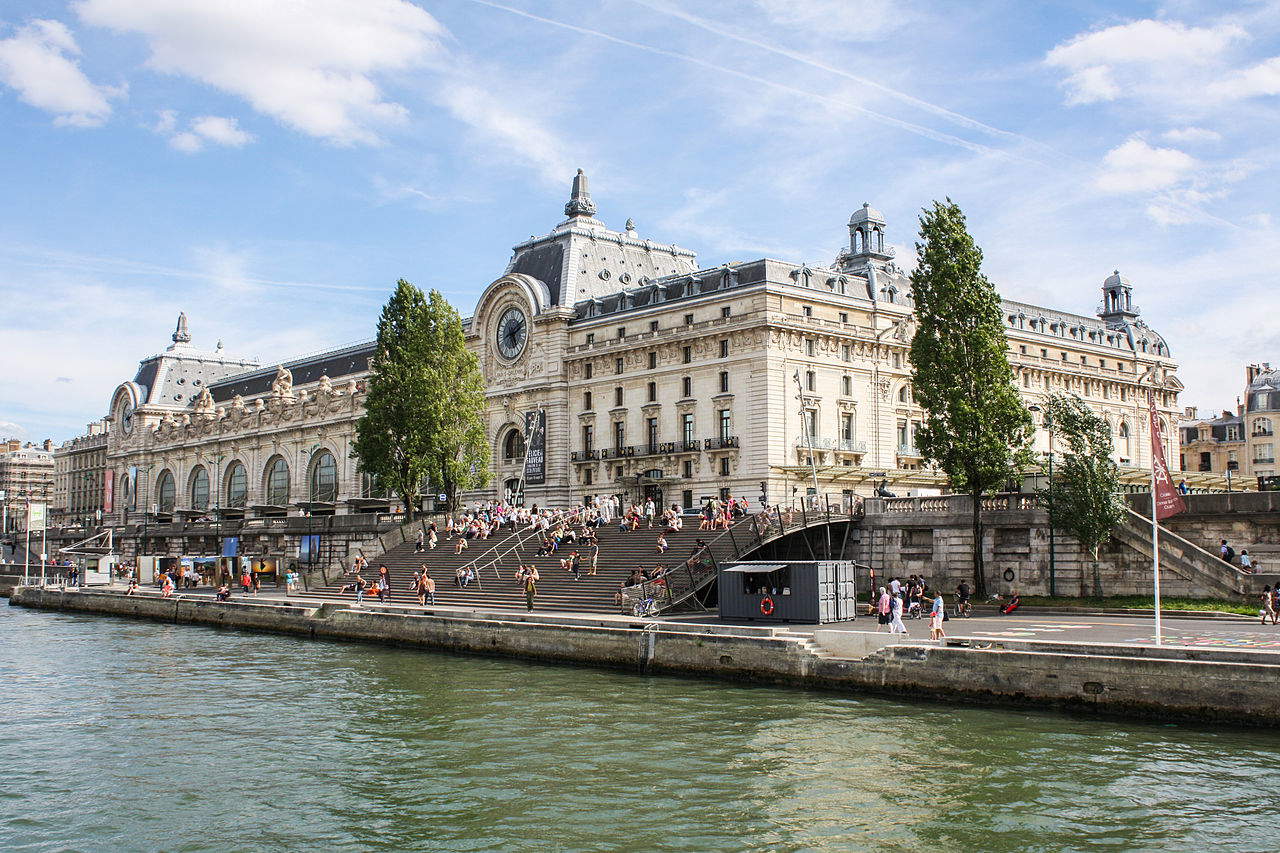 |
| The exterior of the museum. Ph. Shadowgate |
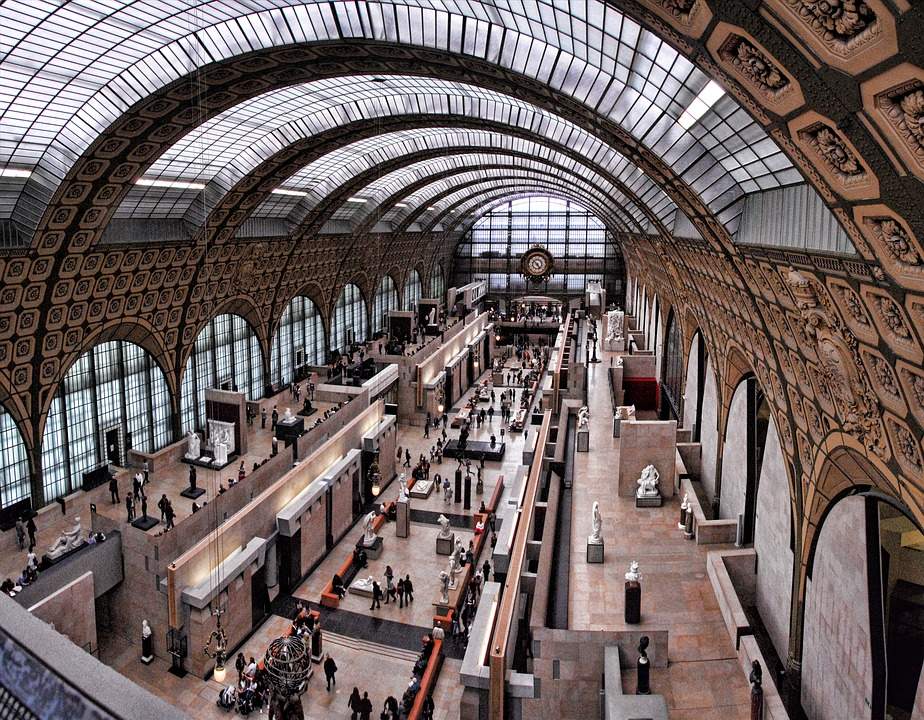 |
| The interior of the museum |
 |
| The interior of the museum |
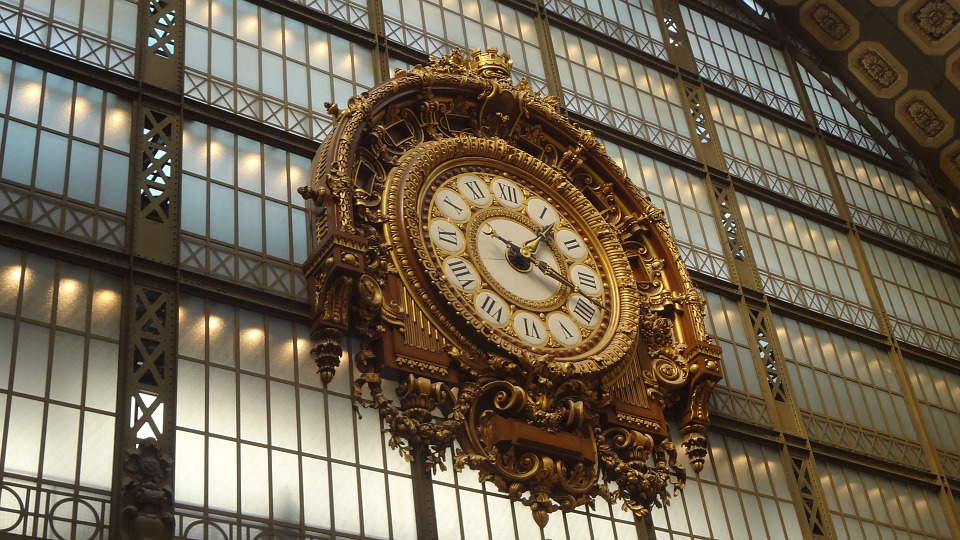 |
| The museum’s clock |
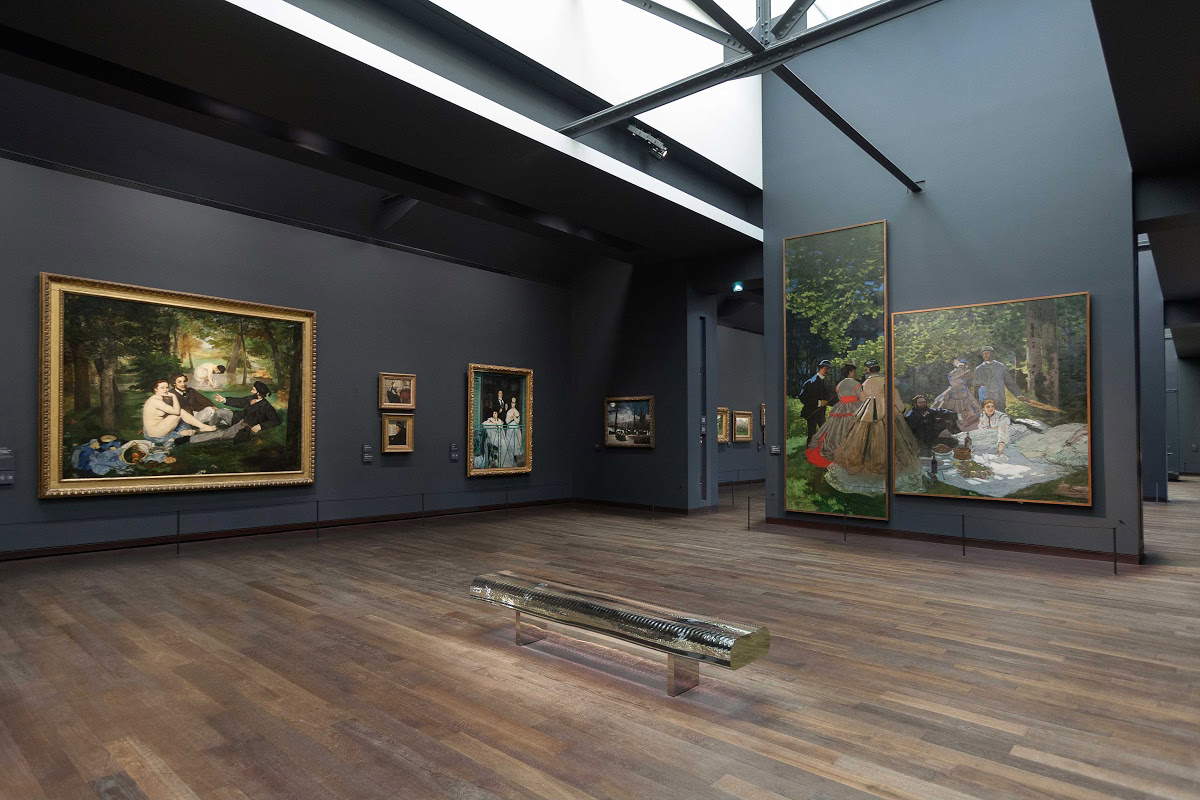 |
| The interior of the museum. |
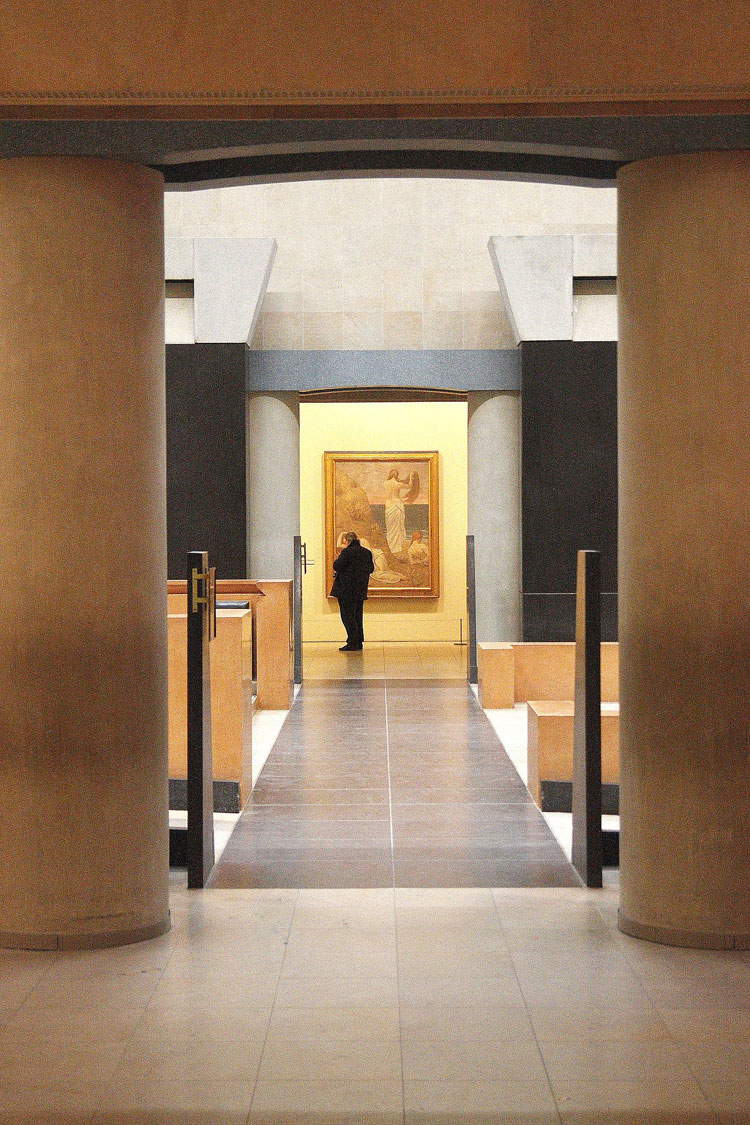 |
| The interior of the museum. Photo by Jean-François Gornet |
The Musée d’Orsay’s collections document the development of the arts over a period from 1848 to 1914, with works coming from three institutions, namely the Louvre (for artists born since 1820), the Jeu de Paume (from which the works of the Impressionists mainly come), and the Musée d’Art Moderne, which, after moving to the Centre Georges Pompidou, gave the works of artists born after 1870 to the Musée d’Orsay. There are six core collection nuclei: painting, sculpture, art objects, photography, graphic art, and architecture. The Musée d’Orsay’s painting collection originates from that of the Musée de Luxembourg, established in 1818 by King Louis XVIII for the purpose of documenting the paintings of contemporary artists whose works were purchased by the Salons. Initially, the Luxembourg housed exclusively works by artists who painted according to official taste, so its collections did not include more innovative artists, such as Gustave Courbet or Jean-François Millet: only towards the end of the nineteenth century, as a result of donations from private individuals and especially the growth in importance of critics and gallery owners, would the Luxembourg’s collections open up to the avant-garde and begin to receive works by artists such as �?douard Manet (his celebrated Olympia entered it in 1890), Claude Monet, Pierre-Auguste Renoir, Camille Pissarro, Alfred Sisley, other Impressionists, and Courbet and Millet themselves. Decisive was the acquisition of the legacy of painter Gustave Caillebotte, who made it a condition that his works be exhibited to the public: it was 1896 when Caillebotte’s forty Impressionist works entered the Musée du Luxembourg, despite skepticism and protests from academic circles. Since then, the French museum’s collections have never ceased to be enriched with the works of the most innovative artists, and today the Musée d’Orsay, heir to the collections of the Luxembourg, the Musée d’Art Moderne (which in 1937 in turn replaced the Luxembourg and was housed in the Palais de Tokyo) and the Jeu de Paume, which housed the Louvre’s modern art collections, includes masterpieces by Impressionists, Post-Impressionists (from Vincent van Gogh to Paul Cézanne, Paul Gauguin to Pierre Bonnard), Symbolists such as Gustave Moreau and Odilon Redon, Nabis, Expressionists such as Edvard Munch, and many others. Sculptors include Auguste Rodin, Constantin Meunier, Aristide Maillol, Aimé-Jules Dalou, Jean-Baptiste Carpeaux, and many others, and in addition the Musée d’Orsay houses one of Edgar Degas’s examples of the Dancer.
Also of great importance is the photography collection, which came into being in the 1970s, when there was still no public collection dedicated to photography in France.Thus, the decision to endow the Musée d’Orsay with a photographic collection dates back to 1978, which was put together from scratch because the collections inherited by the institution did not count photographs. It was therefore decided to start with a very limited nucleus, from 1848 to 1914, that is, from the years immediately following the invention of photography to the years preceding the birth of modern photography (it was after World War I that experimental photography was born in Germany). The aim of the collection is to follow the developments in the art of photography, especially in the early part of its history. All of the Musée d’Orsay’s collections continue to be enriched through donations, purchases, and bequests. Recent acquisitions include the Breton Boy in Profile, a rare painting by Roderic O’Conor who was an interesting Irish follower of Van Gogh, and then Maurice Denis’s Green Christ, a singular Head of a Young Man from the self-portrait of Filippino Lippi by �?douard Manet, Alexandre-Théohpile Steinlen’s drawings for the weekly Gil Blas, Paul Gauguin’s Red Hat, and the exceptional Hays donation that includes works by Pierre Bonnard, Félix Vallotton, Maurice Denis, Robert Delaunay, Camille Claudel, Odilon Redon, and Amedeo Modigliani.
Those who love Impressionism and visit Paris cannot pass up a visit to the Musée d’Orsay: there is no other such important collection of French works from the late 19th and early 20th centuries in the world. And since the Musée d’Orsay is one of the most visited museums in the world, it can be decisive, in order to avoid queues and long waits to enter, to book your ticket well in advance.
 |
| A museum inside a station: the Musée d'Orsay in Paris, the home of the Impressionists |
Warning: the translation into English of the original Italian article was created using automatic tools. We undertake to review all articles, but we do not guarantee the total absence of inaccuracies in the translation due to the program. You can find the original by clicking on the ITA button. If you find any mistake,please contact us.